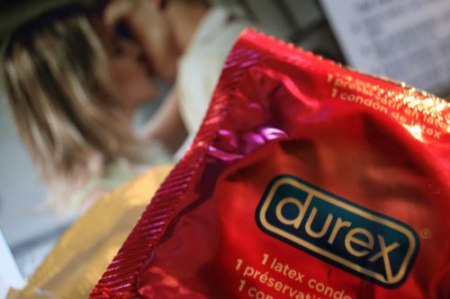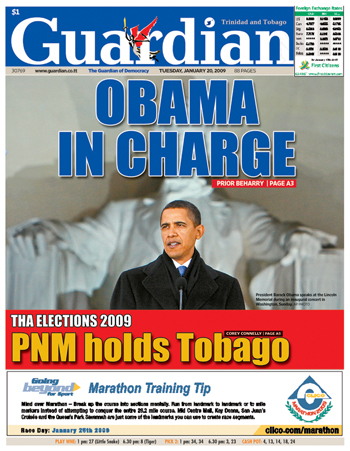
Last year a Trinidadian musician was kind enough to help me out with my final Master’s journalism project, so when a year later he contacted me asking for help on his website, I didn’t hesitate to say yes.
I did, however, hesitate when he insisted on us doing “something fun” alongside our website discussions.
Granted, my recent life since I became a working stiff had gotten fairly boring, but I was still a bit skeptical about attending the event he suggested, which a friend of his was throwing: ladies’ night with male strippers.
I had no idea male stripping was legal in Trinidad. Or female stripping for that matter.
Regardless, I wound up at the event — and my escort, the musician, wasn’t even allowed to sit in the audience since it was ladies’ night.
He hovered somewhere behind with the other males, while I sat in the audience losing whatever smidgen of innocence I might have had left.
But hold up. I’m getting ahead of myself.
Condoms and cockroaches
My first inclination that the night would be interesting was upon entry, when I dutifully collected my free drink from the effeminate (and gorgeous) twink waiter-boy wearing a beaded necklace and gold glitter spandex pants with a huge bulge in the front, and picked up a couple of free condoms (both male and female, mind you!) by the bar.
My escort introduced me to his friends as “a journalist”, though I was already well aware that I would be journalisting nothing tonight.
I made my way over to the rickety chairs surrounding the stage, to sit amidst a thick fog of insect repellant — the purpose of which soon became evident when a few dozen cockroaches scuttled by .
The MC for the night was a man wearing a tube top as a skirt, with a brown cold-weather parka (in 35-degree Trini weather!) and hair in tiny plaits scattered over his head. His makeup was appalling, but not even a fraction as imposing as the lewd suggestive remarks to the crowd.
The first performer was Chi-wa, a slender-bodied Trinidadian graphic artist of Chinese descent. He wore ample tattoos and piercings, and proceeded to draw on himself with a black marker.
His long body contorted rhythmically to the music as he writhed on a chair and peeled off his clothing, until he finally pulled at his underwear suggestively before hiding the goods from the audience that screamed “TAKE IT OFF!”
Erotic art, perhaps?
Well, it was meant to be. It was certainly the most artistic piece.
The night soon descended into gross decadence.
Cutters and Candyman
There was “Cutters” – a teenage boy with a pair of scissors that managed to go on for at least half an hour cutting strips of cloth from his animal-print boxers but still managing to hide the goods — until an audience member finally snatched it away as he walked through the crowd when he left the stage.
He kept looking at the audience with something that surely was meant to be seduction but sadly came off as merely bewildered exhibitionism.
There was “Candyman” – who took off a sweater, a forest-green vest, black roomy pants, and then allowed an audience member to disrobe him from the multicoloured net shorts with underwear that unraveled at the pull of a string.
He proceeded to jump atop my lap despite my insistent shoves and pleads to get the hell away.
Congo and Cunt
There was “Oompawoompa” – whose silhouette scampered across a white sheet as he masturbated and beat his flaccid penis on the back of a chair.
The Mighty Sparrow’s “Congo Man” (tsk tsk, if the Birdie only knew about this usage of his song!) played on and on and on repeatedly as the audience grew restless.
A huge round of applause exploded when he finally pulled back on his yellow-and-red thong and ran off the stage in a Carnival mask.
There was “Office Boy” – a good-looking sex-god with dreadlocks, crawling around on the stage to “You Spin Me Right Round Baby Right Round” as he quivered his pectoral muscles and peeled off his shirt, jacket, “Cunt my anti-drug” t-shirt, knee-length shorts, grey vest, grey brief shorts, and thong under that (wayyyy too much wrapping to get to the present).
Why couldn’t he be the one who insisted on humping me, instead of Candyman? (But I digress….)
Cocktails and cock
Showerman took the cake, though.
While every other performer flirted with nudity but held back that vital shred of cloth, Showerman went all out under the hose and bucket as he rocked back and forth on the steps, exposing full frontal (and well-endowed) nudity, to the rampant cheers of the ecstatic audience.
But the real performer — who was called back repeatedly by request — was Barman, who shook it up and stirred it up to the female delight, removing his jeans behind the apron to expose tight black-and-red briefs and a six-pack washboard stomach, to the tune of “Blame It On The Alcohol” (what else?)
There were a few more that, thankfully, I missed when I ran off to use the bathroom after someone dumped some beer on my legs…
At the end the boys/men all lined up for a final dance-off, and then many of them humped a few ladies in the audience (thankfully this time no one came near me for humping purposes).
One did, however, come up to extend his hand on my way out.
“I’m Martin,” he said politely.
I shook his hand and said my name before I hightailed it out of there.
Journalisting…
As anticipated, no journalisting got done that night — it took me a full week and a half to process the night to even bang out this blog review.
What journalisting should I have done, now that I think of it?
What do you ask a young Trini man who is beating his penis against the back of a chair for a ladies’ night extravagazna?
“So… how did you get into stripping?”
“Do you enjoy it?”
“Does it pay well?”
“Do you have a girlfriend?” (…Or boyfriend, for that matter?… I’m open-minded)
“So, like… does your body (read: penis) have to be a particular dimension to qualify to enter this event?”
“…Little boy, WHERE ARE YOUR PARENTS?”
Hmmm….
But the night was memorable and at times even enjoyable, journalisting or no journalisting.
!!!!!!!!!!!!!!!!!!!!!!!!!!!!!!!!!!!!!!!!!!!!!!!!!!!
Me, ever the world-weary trekker to all corners of the globe, methinks: London, oh sweet pedagogue of so much, London my love… YOU DID NOT PREPARE ME FOR THIS.
But, I suppose, it was good to know there are many corners of Trinidad I have yet to experience.
……………………………..It wasn’t until I was in the car on the way home that I realised the last thing Martin touched before he touched my hand… was most likely his penis.
!!!!!!!!!!!!!!!!!!!!!!!!!!!!!!!!!!!!!!!!!!!!!!!!!!!








COCKS, CONDOMS & COCKROACHES
August 7, 2010Last year a Trinidadian musician was kind enough to help me out with my final Master’s journalism project, so when a year later he contacted me asking for help on his website, I didn’t hesitate to say yes.
I did, however, hesitate when he insisted on us doing “something fun” alongside our website discussions.
Granted, my recent life since I became a working stiff had gotten fairly boring, but I was still a bit skeptical about attending the event he suggested, which a friend of his was throwing: ladies’ night with male strippers.
I had no idea male stripping was legal in Trinidad. Or female stripping for that matter.
Regardless, I wound up at the event — and my escort, the musician, wasn’t even allowed to sit in the audience since it was ladies’ night.
He hovered somewhere behind with the other males, while I sat in the audience losing whatever smidgen of innocence I might have had left.
But hold up. I’m getting ahead of myself.
Condoms and cockroaches
My first inclination that the night would be interesting was upon entry, when I dutifully collected my free drink from the effeminate (and gorgeous) twink waiter-boy wearing a beaded necklace and gold glitter spandex pants with a huge bulge in the front, and picked up a couple of free condoms (both male and female, mind you!) by the bar.
My escort introduced me to his friends as “a journalist”, though I was already well aware that I would be journalisting nothing tonight.
I made my way over to the rickety chairs surrounding the stage, to sit amidst a thick fog of insect repellant — the purpose of which soon became evident when a few dozen cockroaches scuttled by .
The MC for the night was a man wearing a tube top as a skirt, with a brown cold-weather parka (in 35-degree Trini weather!) and hair in tiny plaits scattered over his head. His makeup was appalling, but not even a fraction as imposing as the lewd suggestive remarks to the crowd.
The first performer was Chi-wa, a slender-bodied Trinidadian graphic artist of Chinese descent. He wore ample tattoos and piercings, and proceeded to draw on himself with a black marker.
His long body contorted rhythmically to the music as he writhed on a chair and peeled off his clothing, until he finally pulled at his underwear suggestively before hiding the goods from the audience that screamed “TAKE IT OFF!”
Erotic art, perhaps?
Well, it was meant to be. It was certainly the most artistic piece.
The night soon descended into gross decadence.
Cutters and Candyman
There was “Cutters” – a teenage boy with a pair of scissors that managed to go on for at least half an hour cutting strips of cloth from his animal-print boxers but still managing to hide the goods — until an audience member finally snatched it away as he walked through the crowd when he left the stage.
He kept looking at the audience with something that surely was meant to be seduction but sadly came off as merely bewildered exhibitionism.
There was “Candyman” – who took off a sweater, a forest-green vest, black roomy pants, and then allowed an audience member to disrobe him from the multicoloured net shorts with underwear that unraveled at the pull of a string.
He proceeded to jump atop my lap despite my insistent shoves and pleads to get the hell away.
Congo and Cunt
There was “Oompawoompa” – whose silhouette scampered across a white sheet as he masturbated and beat his flaccid penis on the back of a chair.
The Mighty Sparrow’s “Congo Man” (tsk tsk, if the Birdie only knew about this usage of his song!) played on and on and on repeatedly as the audience grew restless.
A huge round of applause exploded when he finally pulled back on his yellow-and-red thong and ran off the stage in a Carnival mask.
There was “Office Boy” – a good-looking sex-god with dreadlocks, crawling around on the stage to “You Spin Me Right Round Baby Right Round” as he quivered his pectoral muscles and peeled off his shirt, jacket, “Cunt my anti-drug” t-shirt, knee-length shorts, grey vest, grey brief shorts, and thong under that (wayyyy too much wrapping to get to the present).
Why couldn’t he be the one who insisted on humping me, instead of Candyman? (But I digress….)
Cocktails and cock
Showerman took the cake, though.
While every other performer flirted with nudity but held back that vital shred of cloth, Showerman went all out under the hose and bucket as he rocked back and forth on the steps, exposing full frontal (and well-endowed) nudity, to the rampant cheers of the ecstatic audience.
But the real performer — who was called back repeatedly by request — was Barman, who shook it up and stirred it up to the female delight, removing his jeans behind the apron to expose tight black-and-red briefs and a six-pack washboard stomach, to the tune of “Blame It On The Alcohol” (what else?)
There were a few more that, thankfully, I missed when I ran off to use the bathroom after someone dumped some beer on my legs…
At the end the boys/men all lined up for a final dance-off, and then many of them humped a few ladies in the audience (thankfully this time no one came near me for humping purposes).
One did, however, come up to extend his hand on my way out.
“I’m Martin,” he said politely.
I shook his hand and said my name before I hightailed it out of there.
Journalisting…
As anticipated, no journalisting got done that night — it took me a full week and a half to process the night to even bang out this blog review.
What journalisting should I have done, now that I think of it?
What do you ask a young Trini man who is beating his penis against the back of a chair for a ladies’ night extravagazna?
“So… how did you get into stripping?”
“Do you enjoy it?”
“Does it pay well?”
“Do you have a girlfriend?” (…Or boyfriend, for that matter?… I’m open-minded)
“So, like… does your body (read: penis) have to be a particular dimension to qualify to enter this event?”
“…Little boy, WHERE ARE YOUR PARENTS?”
Hmmm….
But the night was memorable and at times even enjoyable, journalisting or no journalisting.
!!!!!!!!!!!!!!!!!!!!!!!!!!!!!!!!!!!!!!!!!!!!!!!!!!!
Me, ever the world-weary trekker to all corners of the globe, methinks: London, oh sweet pedagogue of so much, London my love… YOU DID NOT PREPARE ME FOR THIS.
But, I suppose, it was good to know there are many corners of Trinidad I have yet to experience.
……………………………..It wasn’t until I was in the car on the way home that I realised the last thing Martin touched before he touched my hand… was most likely his penis.
!!!!!!!!!!!!!!!!!!!!!!!!!!!!!!!!!!!!!!!!!!!!!!!!!!!
Posted in Art & Culture, Commentary, Entertainment, journalism | Tagged Bohemia, erotic art, male strippers, Trinidadian nightlife | Leave a Comment »